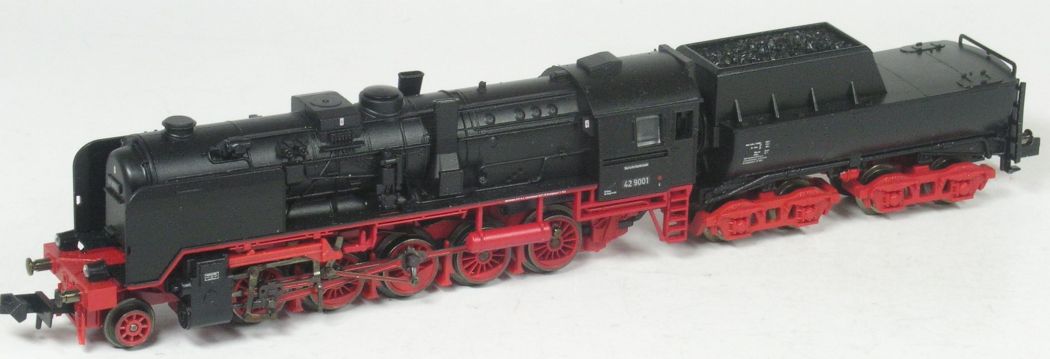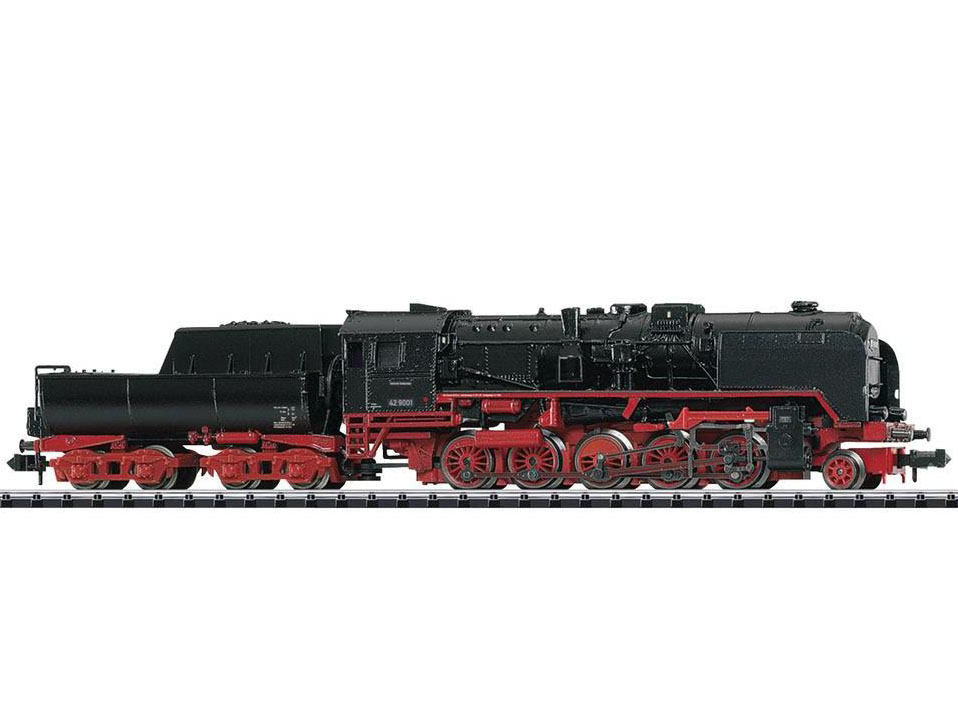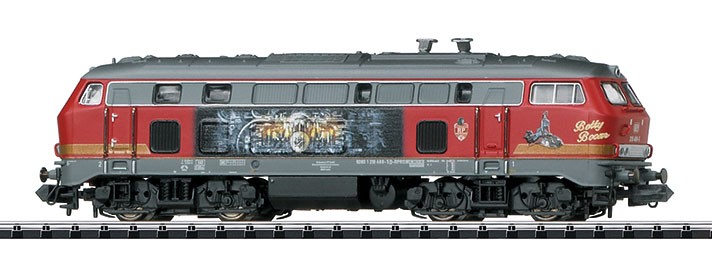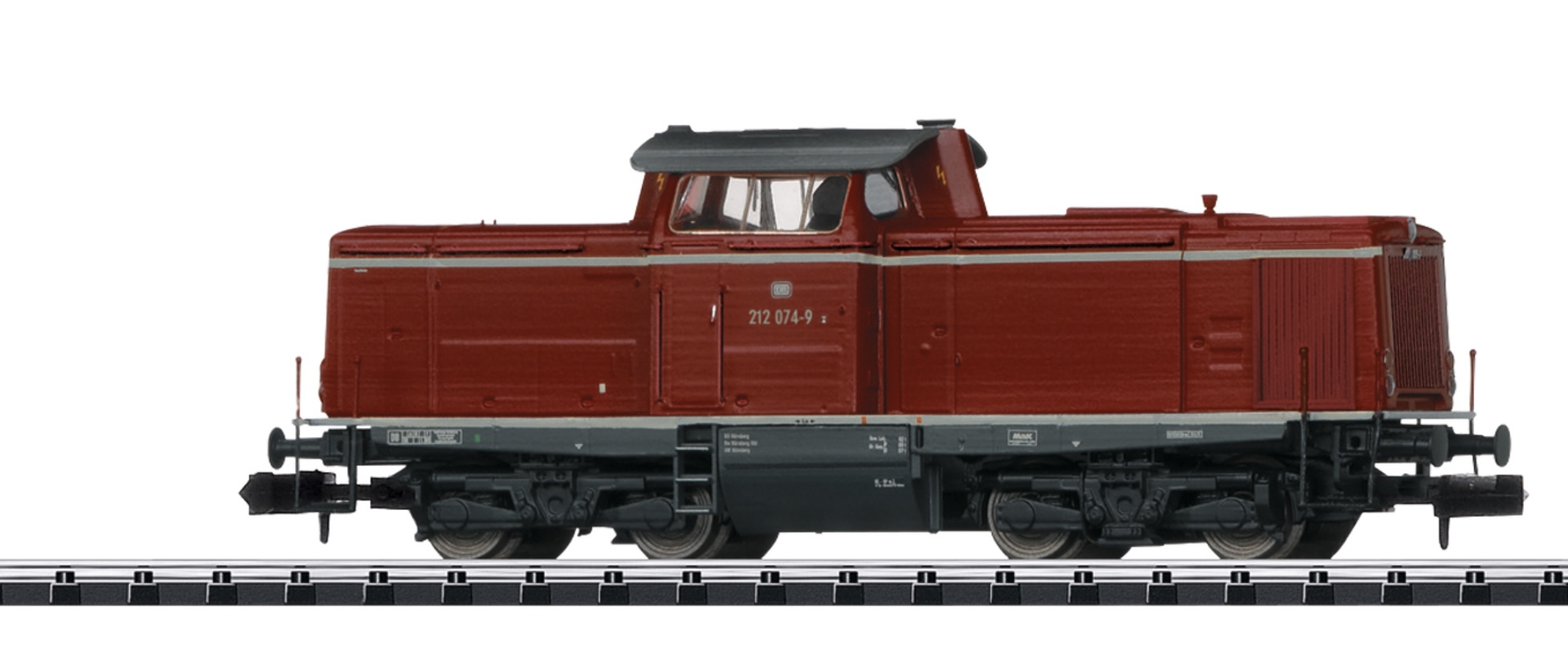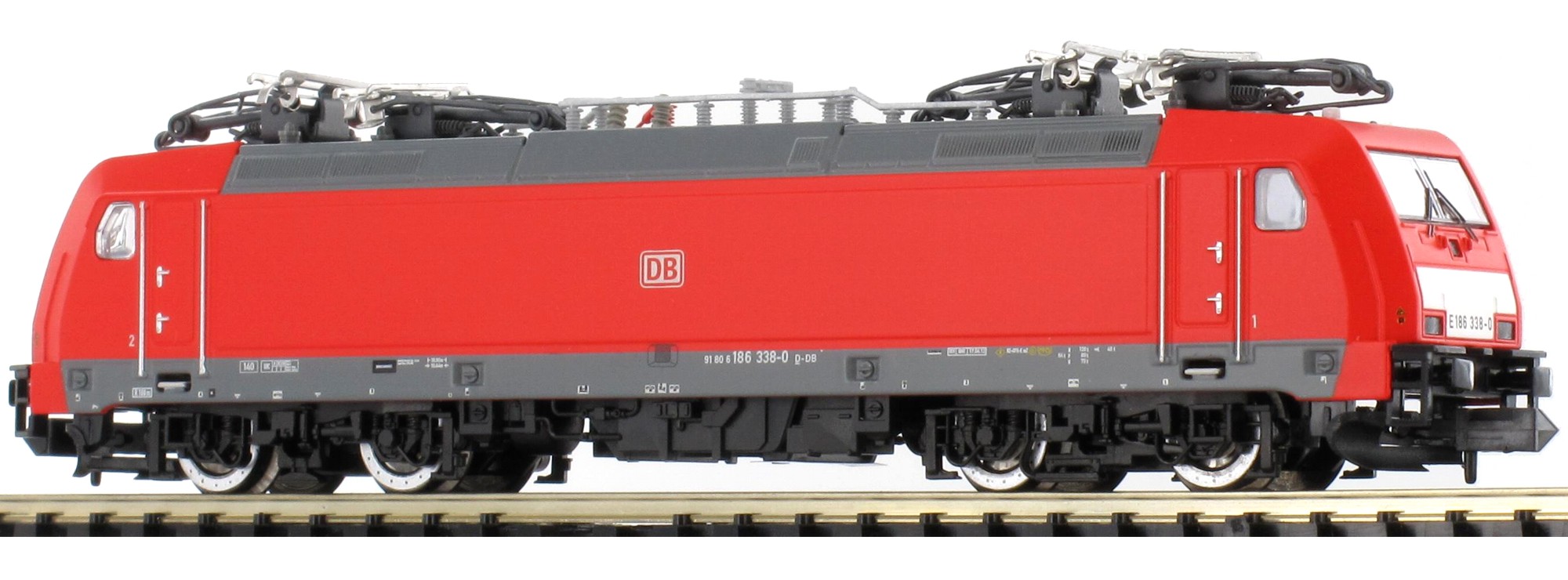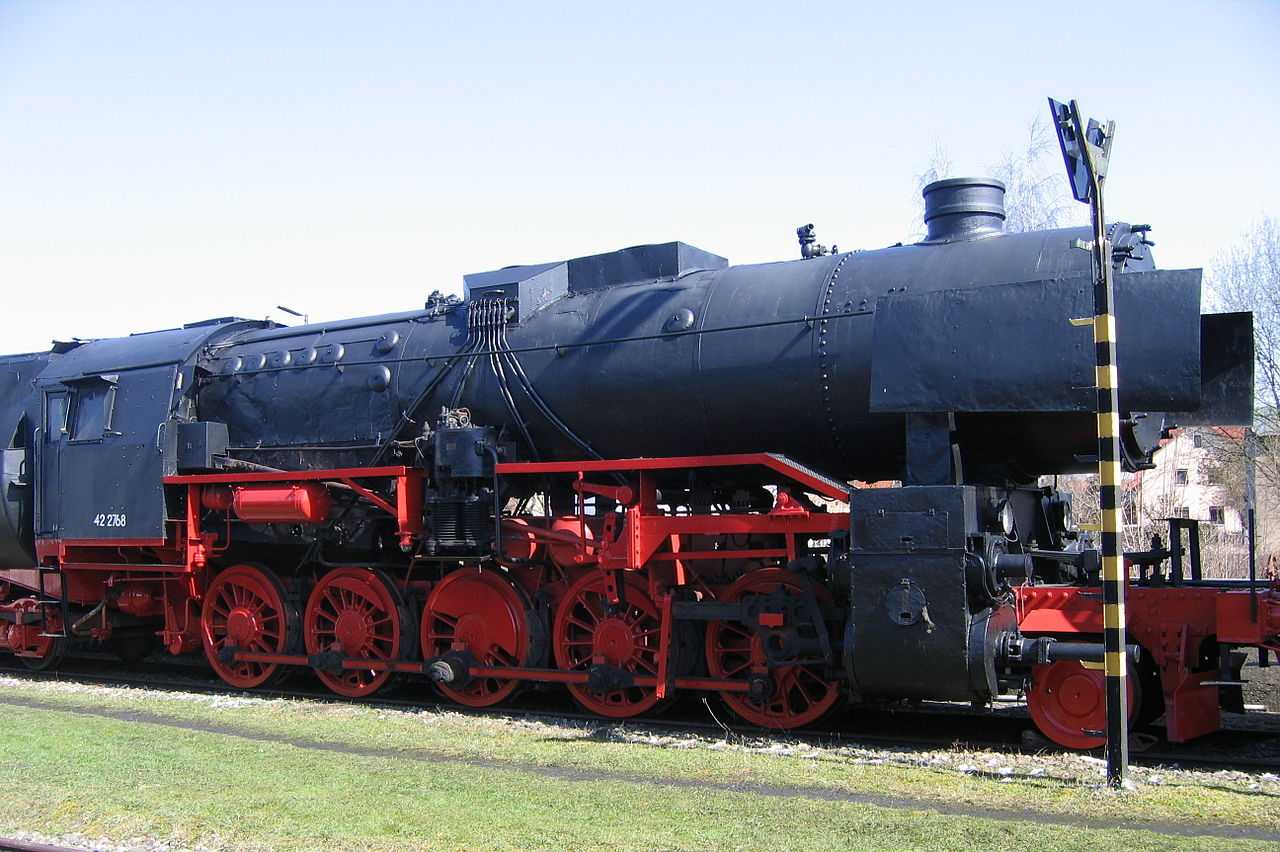Specific Item Information: Accepts mTc 14 digital decoder.
Prototype History: These engines, built from 1943 onwards, were the second heavy locomotive class of this type after the DRG Class 52. They were built for duties on routes that were cleared for a higher axle load, because they were more economical there than the KDL 1 Kriegslokomotiven of Class 52. In principle they were slimmed down 44s. The Class 42 was procured as Kriegslokomotive KDL 3.
The total of 859 units had a number of improvements to the driving and running gear. Originally it was intended to build very large numbers of these engines, but the end of the Second World War put paid to that. A condenser locomotive, based on the Class 42 was also planned, but did not come to fruition.
At the end of the war there were still half-finished engines in the workshops. So after 1945, 16 engines were built for the Reichsbahn in the western zone by the Maschinenfabrik Esslingen ('Esslingen Locomotive Works'). 126 engines were built by Polish factories for the PKP in Poland as Class Ty43 and three ex DRG engines also went over to the PKP as Class Ty3. Another 76 units were produced by the Lokomotivfabrik Floridsdorf in Vienna. These were not built for the Austrian Federal Railways (ÖBB), but were sold in 1949 to the CFL in Luxembourg - 20 engines (CFL class 55), in 1952 to Bulgarian State Railways (BDZ) - 33 pcs (BDZ class 16). and the rest to DR and various industrial enterprises in East Germany.
In 1952, the firm of Henschel rebuilt locomotives 52 893 and 52 894 with Franco-Crosti economisers (Abgasvorwärmer). Because of the resulting higher axle load, the engines were classified by the Deutsche Bundesbahn as Class 42.90 locomotives and given the operating numbers 42 9000 and 42 9001.
The total of 859 units had a number of improvements to the driving and running gear. Originally it was intended to build very large numbers of these engines, but the end of the Second World War put paid to that. A condenser locomotive, based on the Class 42 was also planned, but did not come to fruition.
At the end of the war there were still half-finished engines in the workshops. So after 1945, 16 engines were built for the Reichsbahn in the western zone by the Maschinenfabrik Esslingen ('Esslingen Locomotive Works'). 126 engines were built by Polish factories for the PKP in Poland as Class Ty43 and three ex DRG engines also went over to the PKP as Class Ty3. Another 76 units were produced by the Lokomotivfabrik Floridsdorf in Vienna. These were not built for the Austrian Federal Railways (ÖBB), but were sold in 1949 to the CFL in Luxembourg - 20 engines (CFL class 55), in 1952 to Bulgarian State Railways (BDZ) - 33 pcs (BDZ class 16). and the rest to DR and various industrial enterprises in East Germany.
In 1952, the firm of Henschel rebuilt locomotives 52 893 and 52 894 with Franco-Crosti economisers (Abgasvorwärmer). Because of the resulting higher axle load, the engines were classified by the Deutsche Bundesbahn as Class 42.90 locomotives and given the operating numbers 42 9000 and 42 9001.
Road Name History: 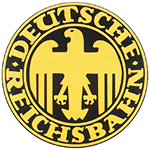 The Deutsche Reichsbahn, also known as the German Reich Railway or the German Imperial Railway, was the name of the German national railway created from the railways of the individual states of the German Empire following the end of World War I.
The Deutsche Reichsbahn, also known as the German Reich Railway or the German Imperial Railway, was the name of the German national railway created from the railways of the individual states of the German Empire following the end of World War I.
The company was founded in 1920 as the Deutsche Reichseisenbahnen when the Weimar Republic, formally known as Deutsches Reich (German Reich, hence the usage of the Reich in the name of the railway), took national control of the German railways, which had previously been run by the German states. In 1924 it was reorganised under the aegis of the Deutsche Reichsbahn-Gesellschaft (DRG), a nominally private railway company, which was 100% owned by the German state. In 1937 the railway was reorganised again as a state authority and given the name Deutsche Reichsbahn (DRB). After the Anschluss in 1938 the DR also took over the Bundesbahn Osterreich (BBO, Federal Railway of Austria).
The East and West German states were founded in 1949. East Germany took over the control of the DR on its territory and continued to use the traditional name Deutsche Reichsbahn, while the railway in West Germany became the Deutsche Bundesbahn (DB, German Federal Railway). The Austrian Osterreichische Bundesbahnen (OBB, Austrian Federal Railways) was founded in 1945, and was given its present name in 1947.
In January 1994, following the German union, the East German Deutsche Reichsbahn merged with the West German Deutsche Bundesbahn to form Germany's new national carrier, Deutsche Bahn AG, technically no longer a government agency but still a 100% state-owned joint stock company.

The company was founded in 1920 as the Deutsche Reichseisenbahnen when the Weimar Republic, formally known as Deutsches Reich (German Reich, hence the usage of the Reich in the name of the railway), took national control of the German railways, which had previously been run by the German states. In 1924 it was reorganised under the aegis of the Deutsche Reichsbahn-Gesellschaft (DRG), a nominally private railway company, which was 100% owned by the German state. In 1937 the railway was reorganised again as a state authority and given the name Deutsche Reichsbahn (DRB). After the Anschluss in 1938 the DR also took over the Bundesbahn Osterreich (BBO, Federal Railway of Austria).
The East and West German states were founded in 1949. East Germany took over the control of the DR on its territory and continued to use the traditional name Deutsche Reichsbahn, while the railway in West Germany became the Deutsche Bundesbahn (DB, German Federal Railway). The Austrian Osterreichische Bundesbahnen (OBB, Austrian Federal Railways) was founded in 1945, and was given its present name in 1947.
In January 1994, following the German union, the East German Deutsche Reichsbahn merged with the West German Deutsche Bundesbahn to form Germany's new national carrier, Deutsche Bahn AG, technically no longer a government agency but still a 100% state-owned joint stock company.
Brand/Importer Information: Trix is a German company that originally made Trix metal construction sets. one of its co-founders was Stephan Bing, the son of the pioneer toy-maker industrialist Ignaz Bing. In 1935 the company began producing the electrically powered model trains that it became famous for, under the Trix Express label. Prior to the outbreak of World War II the Trix company produced a small range of fairly unrealistic AC powered three rail models running at 14 volts.
N gauge models under the Minitrix brand were made from the late 1960s mostly of European prototypes (German and British primarily). North American prototypes were also manufactured and marketed under the Aurora "Postage Stamp" brand; later these items were sold under the American Tortoise, Model Power and Con-Cor brands. Trix sometimes utilized North American consultants to aid in the design of this portion of the product line. The "Hornby Minitrix' brand was used in the 1980s for a short lived range of British outline models using the earlier product tooling.
Trix's owner in the 1980s and 1990s was Mangold, which went bankrupt in the late 1990s and Märklin purchased the assets in January 1997. In part, this purchase was a reflection of Märklin's need for added production capacity; Trix had been manufacturing certain items for Märklin in previous years. The purchase was also in response to the earlier purchase of the Karl Arnold company by the Italian company Rivarossi; Märklin were very keen to take over Trix market share in 2-rail H0 and especially Minitrix, until then Märklin had not marketed N gauge models. In 2003, Märklin introduced its first N gauge models under the well established Minitrix brand. A number Märklin H0 scale three-rail AC locomotives have also been introduced in two-rail DC versions under the Trix logo and many models are shared between the two brands.
From Wikipedia
N gauge models under the Minitrix brand were made from the late 1960s mostly of European prototypes (German and British primarily). North American prototypes were also manufactured and marketed under the Aurora "Postage Stamp" brand; later these items were sold under the American Tortoise, Model Power and Con-Cor brands. Trix sometimes utilized North American consultants to aid in the design of this portion of the product line. The "Hornby Minitrix' brand was used in the 1980s for a short lived range of British outline models using the earlier product tooling.
Trix's owner in the 1980s and 1990s was Mangold, which went bankrupt in the late 1990s and Märklin purchased the assets in January 1997. In part, this purchase was a reflection of Märklin's need for added production capacity; Trix had been manufacturing certain items for Märklin in previous years. The purchase was also in response to the earlier purchase of the Karl Arnold company by the Italian company Rivarossi; Märklin were very keen to take over Trix market share in 2-rail H0 and especially Minitrix, until then Märklin had not marketed N gauge models. In 2003, Märklin introduced its first N gauge models under the well established Minitrix brand. A number Märklin H0 scale three-rail AC locomotives have also been introduced in two-rail DC versions under the Trix logo and many models are shared between the two brands.
From Wikipedia
Item created by: gdm on 2019-09-14 10:44:09. Last edited by Alain LM on 2020-05-13 13:56:39
If you see errors or missing data in this entry, please feel free to log in and edit it. Anyone with a Gmail account can log in instantly.
If you see errors or missing data in this entry, please feel free to log in and edit it. Anyone with a Gmail account can log in instantly.


